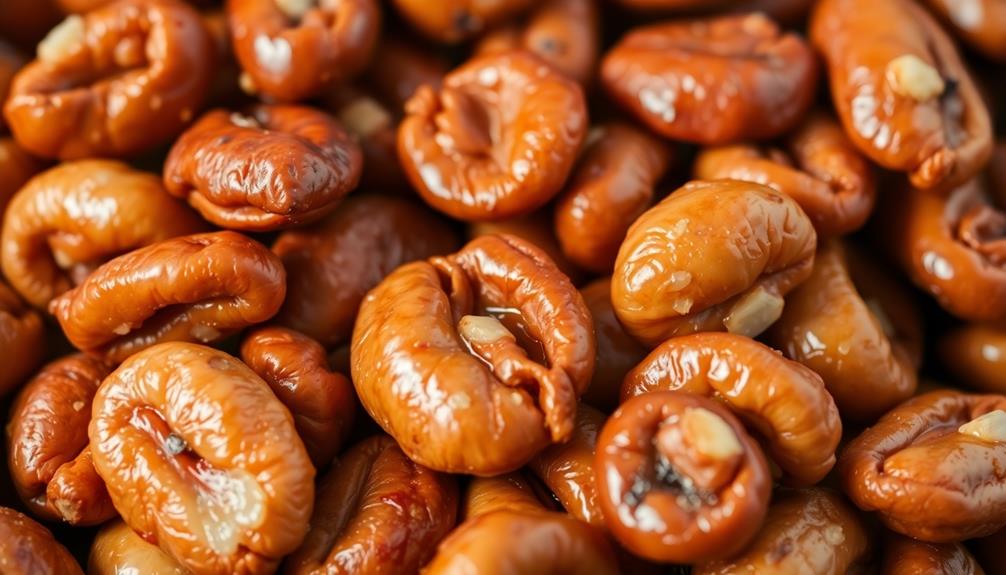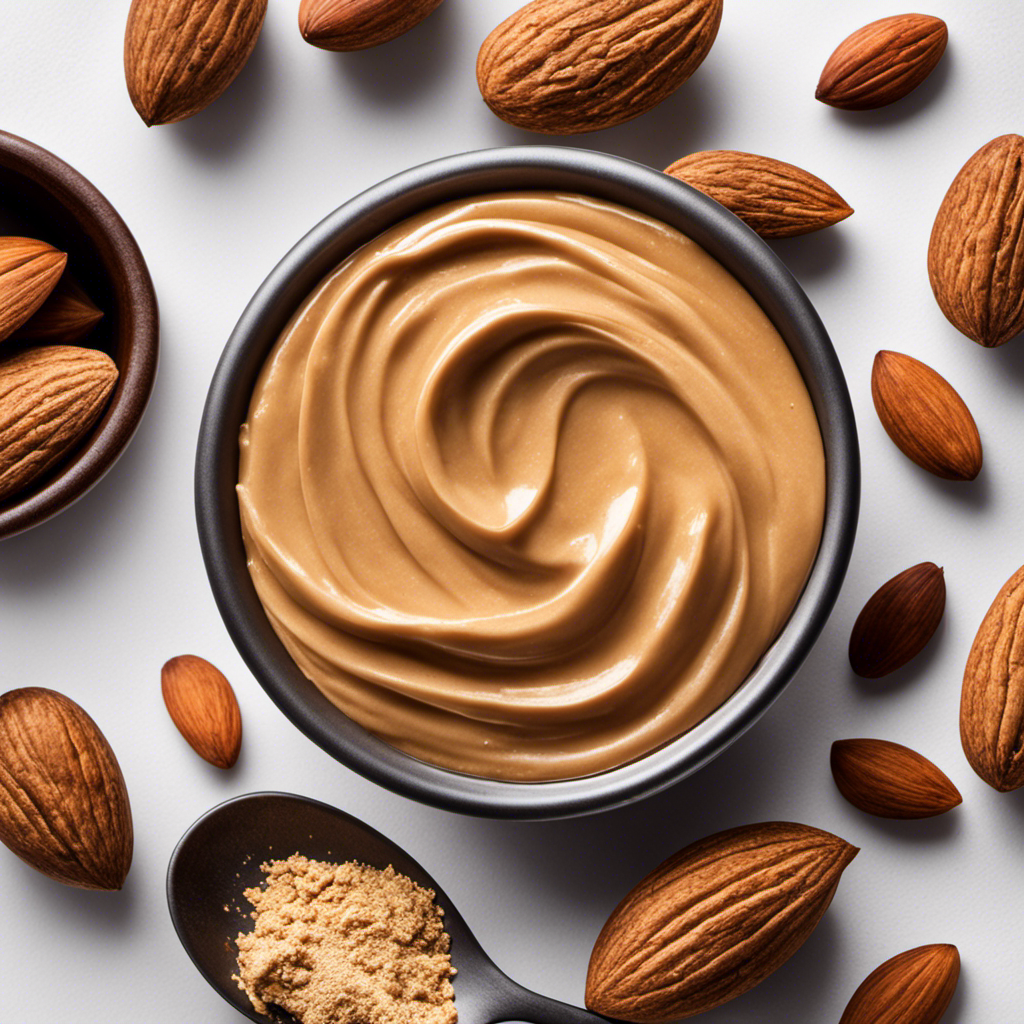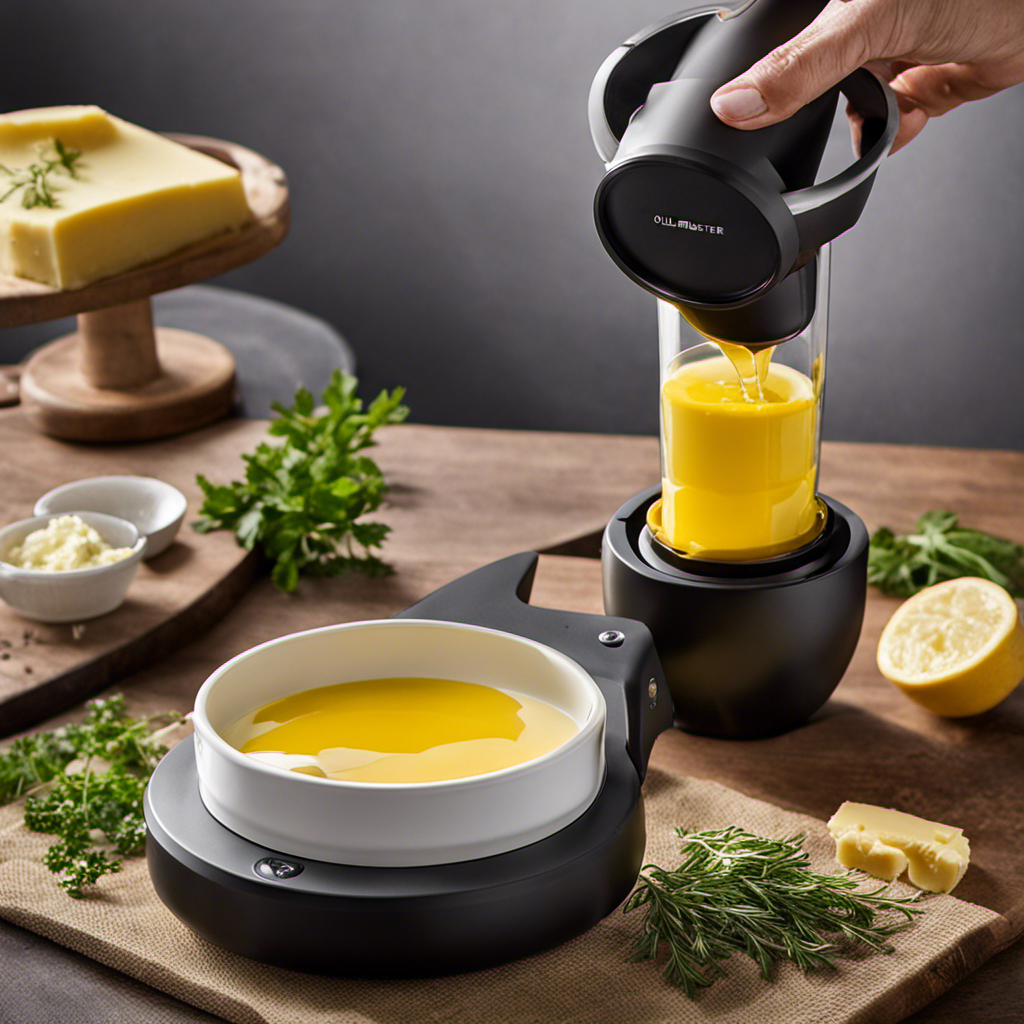Butter-roasted nuts are the ultimate snack, offering a crunchy, buttery delight that'll transport your taste buds to a culinary paradise. Tracing back to ancient civilizations, this timeless treat has captured the hearts of royalty and commoners alike. The secret lies in the perfect harmony of rich, creamy butter and golden-brown nuts, complemented by a symphony of seasonings. Whether you prefer almonds, cashews, or pecans, the key is roasting them to perfection until they're fragrant and irresistible. Dive into this mouthwatering experience, and prepare to savor every satisfying bite. There's more where that came from…
Key Takeaways
- Butter-roasted nuts have a rich history, tracing their origins to ancient civilizations and being cherished as a delicacy by royalty and the elite.
- The combination of crunchy nuts and creamy butter creates a mouthwatering treat that has remained a timeless classic, enjoyed globally as a party snack or holiday gift.
- Roasting the nuts at the optimal temperature of 350°F ensures they achieve a golden-brown color and a satisfying crunch, with the ability to experiment with various seasoning blends.
- Carefully coating the nuts in a butter mixture and stirring them halfway through the roasting process are key steps for evenly distributed flavor and texture.
- The final butter-roasted nuts deliver a delightful flavor profile that is a harmonious blend of salty, sweet, and buttery, making them the ultimate snack for a crunchy, indulgent experience.
History
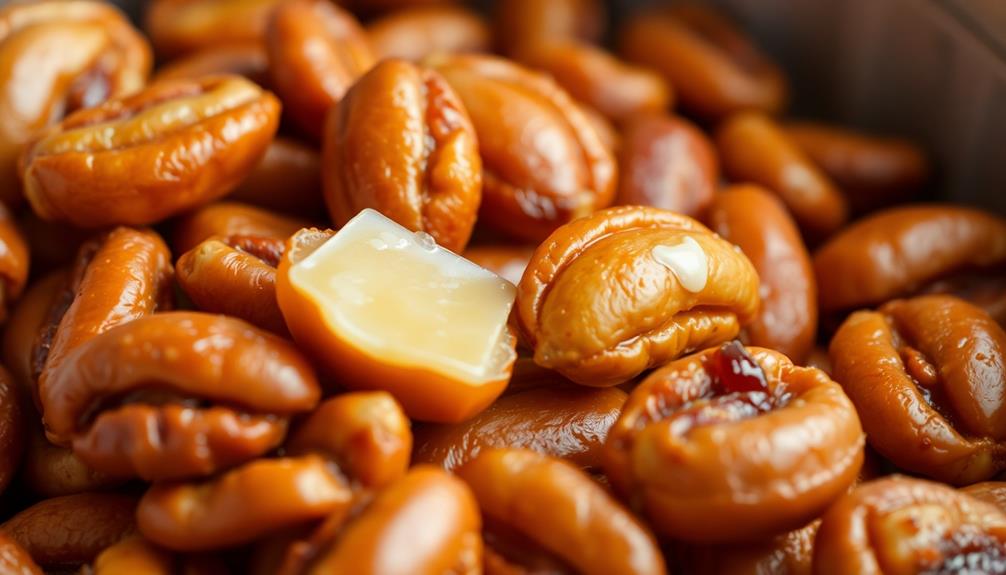
Butter roasted nuts have a long and storied history, dating back centuries. These delectable treats were once a prized delicacy, enjoyed by royalty and the elite. The practice of roasting nuts in butter originated in ancient civilizations, where cooks would carefully toast the nuts to perfection, infusing them with a rich, buttery flavor.
As time passed, the art of butter roasting spread to various cultures, each adding their own unique spin. In the Middle Ages, monks would often prepare these nuts as a special snack for their guests, showcasing their culinary expertise.
Later, European settlers brought the tradition to the New World, where it quickly became a beloved treat among the colonists.
Today, butter roasted nuts remain a timeless classic, enjoyed by people all over the world. Whether as a party snack, a holiday gift, or a simple indulgence, these crunchy, buttery delights continue to captivate our taste buds and evoke memories of simpler, more indulgent times.
Recipe
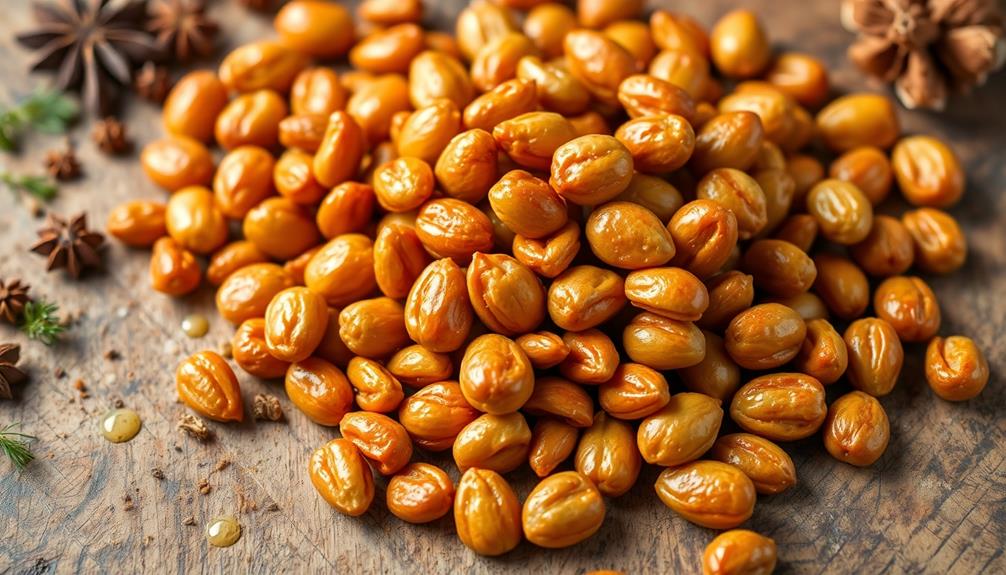
Butter Roasted Nuts is a delightful snack that can be enjoyed any time of the day. The combination of crunchy nuts and rich, creamy butter creates a mouthwatering treat. Whether you're looking for a quick snack or a tasty addition to a charcuterie board, this recipe is sure to impress.
The creamy texture of butter enhances the overall flavor profile, making it an excellent choice for this dish. Additionally, butter's natural fat content helps to bind the seasonings to the nuts, ensuring every bite is flavorful and satisfying.
The key to this recipe is to roast the nuts until they're golden brown and fragrant. The butter melts into the nuts, infusing them with a delicious flavor that's hard to resist. This dish is versatile, as you can use a variety of nuts, such as almonds, cashews, or pecans, depending on your preference.
Ingredients:
- 2 cups mixed nuts (such as almonds, cashews, pecans)
- 2 tablespoons unsalted butter, melted
- 1 teaspoon sea salt
Instructions:
Preheat your oven to 350°F (175°C). Spread the mixed nuts on a baking sheet in a single layer. Drizzle the melted butter over the nuts and toss to coat evenly. Sprinkle the sea salt over the nuts and give them another gentle toss to distribute the salt.
Roast the nuts for 12-15 minutes, stirring halfway, until they're golden brown and fragrant.
When it comes to extra tips, it's important to keep a close eye on the nuts while they're roasting to prevent them from burning. Additionally, you can experiment with different seasoning blends, such as chili powder, cumin, or even a touch of brown sugar, to add extra flavor to the roasted nuts.
For a unique twist, consider using compound butter to introduce additional flavors into your roasted nuts.
Cooking Steps
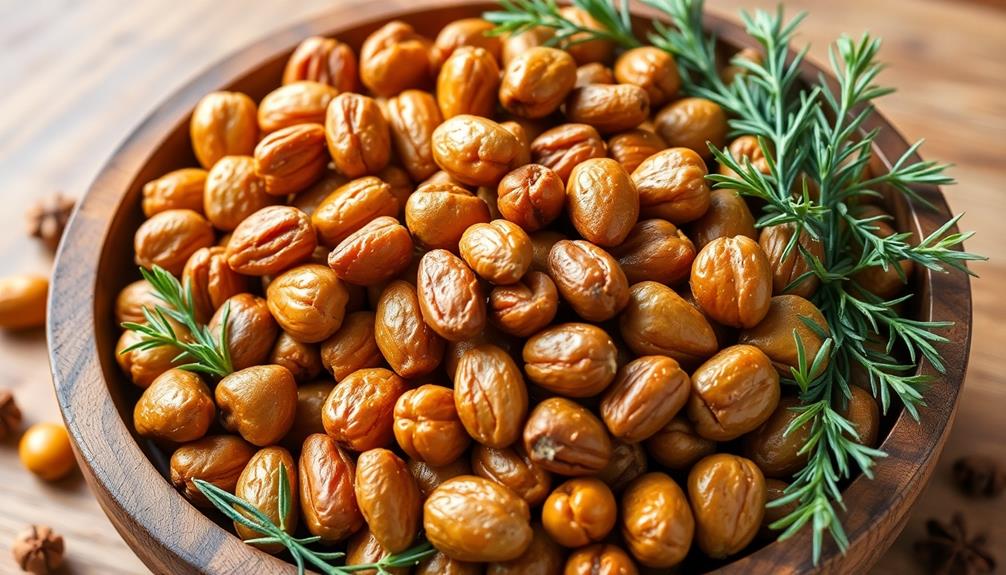
Alrighty, let's get your oven preheated to 350°F.
Once that's ready, go ahead and toss those nuts in the butter mixture until they're all nicely coated.
Now, spread that nut mixture out on a baking sheet and pop it in the oven for 15 minutes, making sure to give it a good stir halfway through the roasting process.
Step 1. Preheat Oven to 350°F
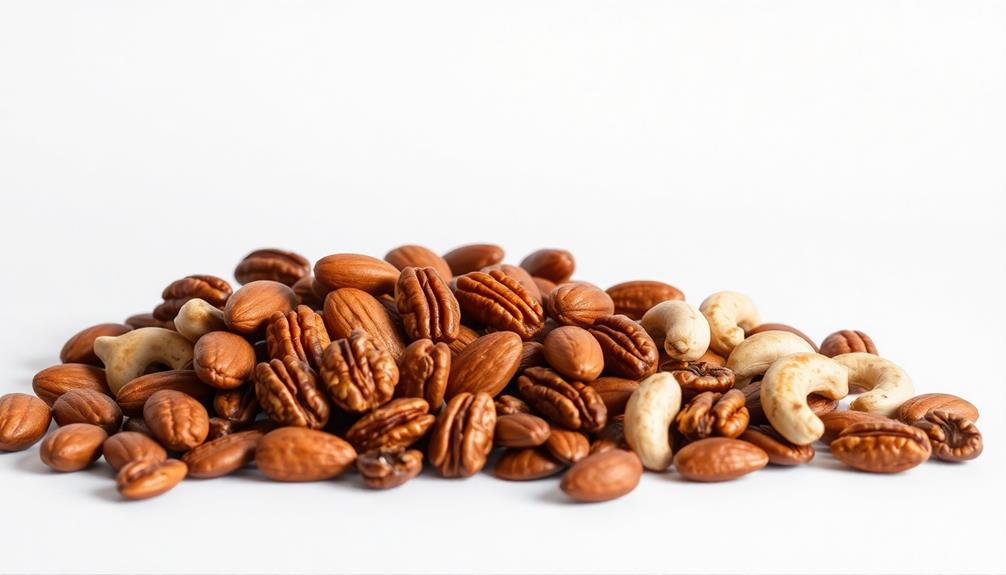
To begin the cooking process, preheat your oven to 350°F. This crucial step ensures your oven is at the perfect temperature for roasting the nuts to a delicious, golden-brown perfection. The consistent heat will evenly cook the nuts, bringing out their natural oils and intensifying their rich, buttery flavor.
Additionally, maintaining a clean and well-ventilated kitchen environment can enhance your cooking experience, just as air purifiers improve indoor air quality by reducing allergens and pollutants improving respiratory health.
As the oven preheats, take a moment to gather your butter, assorted nuts, and any desired seasonings. This will have everything ready to go once the oven is hot. You can even use this time to prepare a baking sheet by lining it with parchment paper or a silicone mat, which will make for easy cleanup later.
Once the oven reaches 350°F, you're ready to begin roasting your nuts. The high heat will transform the simple ingredients into a crave-worthy snack with a satisfyingly crunchy texture and irresistible aroma.
Get ready to enjoy the mouthwatering results of your perfectly preheated oven!
Step 2. Toss Nuts in Butter Mixture
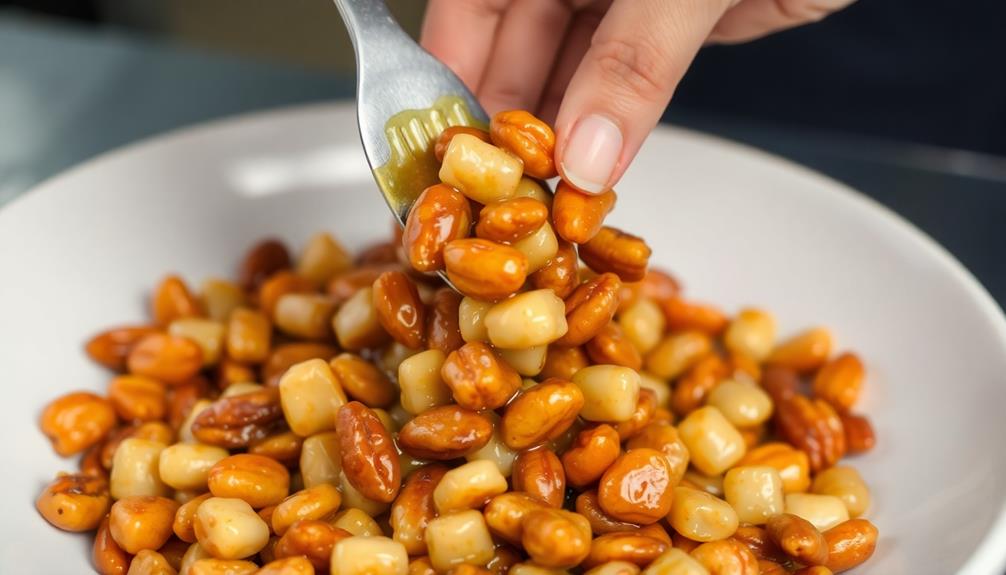
With the oven preheated, it's time to toss the nuts in the butter mixture.
In a large bowl, combine the melted butter, brown sugar, cinnamon, and salt. Stir until the ingredients are well-incorporated, creating a rich, fragrant coating.
Gently add the assorted nuts to the bowl, ensuring each one is evenly coated in the buttery goodness. Using a spatula or your hands, toss the nuts until they're completely covered in the mixture.
The aroma will be absolutely tantalizing, making your mouth water in anticipation. Take a moment to inhale the scent – the sweet cinnamon and toasty nuts are a heavenly combination.
Now, it's time to transfer the coated nuts to the prepared baking sheet, arranging them in a single layer.
The nuts will soon transform in the oven, becoming perfectly crisp and caramelized, ready to be savored as a delightful snack.
Step 3. Spread Nut Mixture on Baking Sheet

Take the coated nuts and evenly spread them out on the prepared baking sheet. You want to create a single layer, ensuring each nut has plenty of space to roast and get that irresistible golden-brown color.
Don't be afraid to use your hands to gently separate any nuts that are stuck together – you want maximum surface area exposure for optimal crispiness. For an extra layer of flavor, consider using compound butter recipes that incorporate herbs or spices to elevate your nut mixture.
Once the nuts are nicely arranged, pop the baking sheet into your preheated oven. Set a timer for 12-15 minutes, keeping a close eye on them as they roast.
The aroma wafting through your kitchen will be mouthwatering, and you'll be tempted to sneak a few before they're done. But trust the process! Those few extra minutes in the oven are crucial for developing that delightful crunch.
When the timer goes off, the nuts should be toasted to perfection, ready for you to indulge in their buttery, roasted goodness.
Step 4. Roast Nuts for 15 Minutes
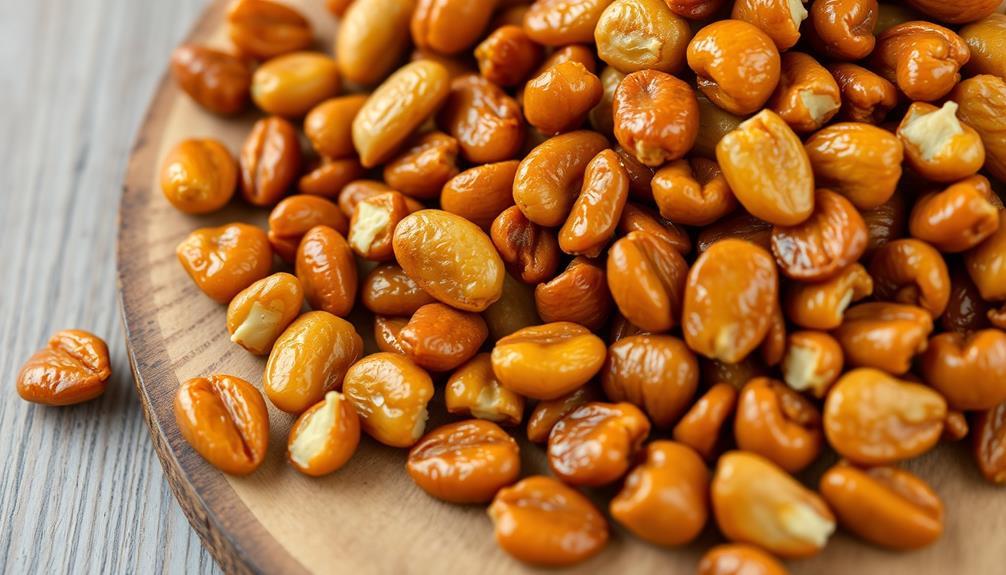
Once the nuts are evenly spread on the baking sheet, you'll want to pop them into the preheated oven. Set the oven temperature to 350°F (175°C) and let the nuts roast for about 15 minutes, giving them a stir halfway through.
The tantalizing aroma of the butter and nuts will start to fill your kitchen, making your mouth water in anticipation. Keep a close eye on them, as nuts can go from perfectly golden to burnt in the blink of an eye.
You'll know they're done when they've developed a delightful crunch and a rich, toasted flavor. The nuts may seem a bit soft when you first take them out, but they'll continue to crisp up as they cool.
Be careful not to overbake them, as you want them to retain their tender, buttery center. Once the timer goes off, carefully remove the baking sheet from the oven and let the nuts cool completely before enjoying their crunchy, buttery goodness.
Step 5. Stir Nuts Halfway Through Roasting
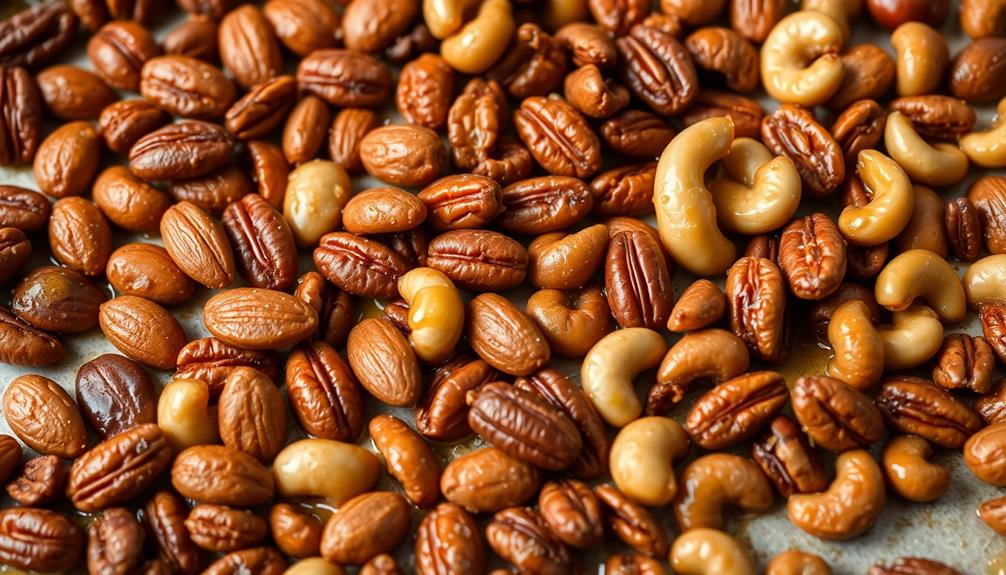
Halfway through the roasting time, open the oven and give the nuts a gentle stir. This simple step ensures even browning and prevents burning.
As the oven door swings open, the tempting aroma of toasted nuts and melted butter will fill the air, making your mouth water in anticipation.
Use a sturdy spatula or wooden spoon to carefully lift and toss the nuts, distributing them evenly across the baking sheet. Pay close attention to the corners and edges, as these areas tend to brown faster.
Gently scrape up any nut pieces that have stuck to the pan, incorporating them back into the mix.
Close the oven door quickly to maintain the oven's temperature, then set a timer for the remaining roasting time. This midpoint stir will help create a delightful crunch and a beautifully golden color throughout the nuts.
Soon, you'll be able to enjoy the irresistible combination of buttery goodness and satisfying crunch.
Final Thoughts
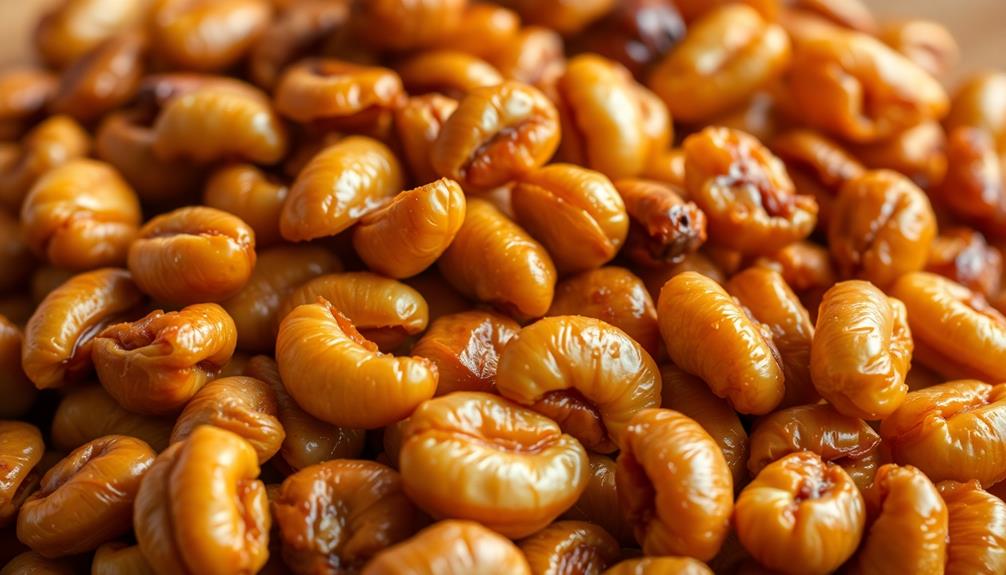
The alluring aroma of butter-roasted nuts lingers, a testament to the satisfying culmination of this culinary journey. As you savor the final, golden-brown morsels, you can't help but feel a sense of pride and accomplishment.
The perfect balance of salty, sweet, and buttery flavors has been achieved, leaving your taste buds delighted and your cravings completely satisfied.
These homemade butter-roasted nuts aren't just a snack – they're an experience. The satisfying crunch and melt-in-your-mouth texture make every bite a delight.
Whether you're enjoying them on their own or incorporating them into a larger dish, these nuts are sure to impress. So, go ahead and indulge in the ultimate treat – your taste buds will thank you.
The next time you're in the mood for a truly exceptional snack, remember the magic of butter-roasted nuts and savor every delectable moment.
Frequently Asked Questions
How Long Do the Roasted Nuts Stay Fresh?
Roasted nuts typically stay fresh for 2-3 weeks when stored in an airtight container at room temperature. To extend their shelf life, you can refrigerate them for up to 6 months or freeze them for up to a year.
Can I Use Different Types of Nuts?
You can absolutely use different types of nuts for roasting. Experiment with a variety of nuts like almonds, walnuts, pecans, or even a mix to create your own customized snack. The possibilities are endless!
Is It Necessary to Use Unsalted Butter?
You don't necessarily need to use unsalted butter. Both salted and unsalted butter will work. However, if you prefer a more controlled flavor, unsalted butter is the way to go. The choice is yours based on your personal taste preferences.
Can I Add Any Other Seasonings?
Absolutely! You can add all sorts of seasonings to your roasted nuts to make them even more flavorful. Try spices like cumin, chili powder, or garlic powder, or even a touch of brown sugar for a sweet-and-savory twist.
How Can I Store the Roasted Nuts?
To store the roasted nuts, let them cool completely before transferring them to an airtight container. This'll keep them fresh and crunchy for up to 2 weeks at room temperature or up to 3 months in the freezer.
